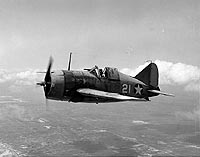
The Brewster F2A, the U.S. Navy's first monoplane shipboard fighter, saw brief combat service during the first half-year of the Pacific War. Built in 1936-38, Brewster's XF2A-1 prototype bested the Grumman XF4F-2 in a competition to replace the Grumman F3F biplane fighter. A production contract for F2A-1 production aircraft followed in June 1938. Production difficulties, a continuing problem throughout the life of the Brewster company, delayed service introduction until late 1939, when F2A-1s began to join USS Saratoga's Fighting Squadron Three (VF-3). Only eleven of the fifty-four F2A-1s entered Navy service. The rest were modified and sold to Finland, where they served with considerable success against Soviet aircraft during 1941-44 and against the Germans in 1944-45. Other versions of the F2A were subsequently employed against the Japanese by the British Royal Air Force and the Netherlands East Indies Army Air Corps.
In 1940, deliveries began of 43 F2A-2 fighters, which had the 1200 horsepower Wright "Cyclone" engine in place of the F2A-1's 950 horsepower version, plus numerous other improvements. Eight F2A-1s were also rebuilt to F2A-2 standards. Initially serving with VF-3 and USS Lexington's VF-2, this model was a fast, nimble and well-armed fighting plane, though plagued (as were subsequent F2As) with an overly-delicate retractable landing gear and a maintenance-hungry powerplant.
The Navy ordered a final 108 Brewster fighters in January 1941. These F2A-3s featured a longer fuselage, increased fuel and ammunition capacity, additional armor and considerably greater weight. Range was better, but speed, maneuverability, climb rate and service ceiling were substantially degraded. By the beginning of the Pacific War, the F2A, by then also known by the popular name "Buffalo", was passing out of carrier squadron service in favor of the F4F-3. The "Buffalos" were transferred to the Marines, who assigned them to units defending Pacific island bases.
The Brewster fighter's only U.S. combat use, on 4 June 1942 during the Battle of Midway, dramatically showed the inferiority of the F2A-3 when confronted by the Japanese Navy's "Zero" carrier fighters and well-trained aviators. In a brief battle against greatly superior numbers, Midway Island's Marine Fighting Squadron 221 (VMF-221) lost thirteen of twenty F2A-3s. Soon after, the "Buffalo" was removed from combat units and assigned to advanced training duty. In that role, it helped new U.S. fighter pilots enhance their skills before they joined operational squadrons. The aging F2A-2s and F2A-3s remained in the trainng mission into 1943, and a few were still in service in 1944-45.
F2A-3 characteristics:
This page features views of Brewster F2A "Buffalo" fighters in flight. It also provides links to virtually all our other pictures of this type of aircraft.
For further views of F2A aircraft, see:
| If you want higher resolution reproductions than the digital images presented here, see: "How to Obtain Photographic Reproductions." |
Click on the small photograph to prompt a larger view of the same image.
|
Photo #: 80-G-3807 Brewster XF2A-1 fighter In flight during tests, circa 1938-39. Official U.S. Navy Photograph, now in the collections of the National Archives. Online Image: 63KB; 740 x 600 pixels Reproductions of this image may also be available through the National Archives photographic reproduction system. |
 |
|
Photo #: NH 97540 Brewster F2A-3 "Buffalo" fighter In flight, 2 August 1942, piloted by Lieutenant Commander Joseph C. Clifton. Official U.S. Navy Photograph, from the collections of the Naval History and Heritage Command. Online Image: 75KB; 740 x 605 pixels |
 |
|
Photo #: 80-G-16053 Brewster F2A-3 "Buffalo" fighter In flight on 2 August 1942. Pilot is Lieutenant Commander Joseph C. Clifton, USN. Official U.S. Navy Photograph, now in the collections of the National Archives. Online Image: 133KB; 740 x 600 pixels Reproductions of this image may also be available through the National Archives photographic reproduction system. |
 |
|
Photo #: 80-G-16055 Brewster F2A-3 "Buffalo" fighter In flight on 2 August 1942. Pilot is Lieutenant Commander Joseph C. Clifton, USN. Official U.S. Navy Photograph, now in the collections of the National Archives. Online Image: 48KB; 740 x 435 pixels Reproductions of this image may also be available through the National Archives photographic reproduction system. |
 |
For further views of F2A aircraft, see:
NOTES:
| If you want higher resolution reproductions than the digital images presented here, see: "How to Obtain Photographic Reproductions." |
Page made 24 March 2001
Coding updated 6 May 2009